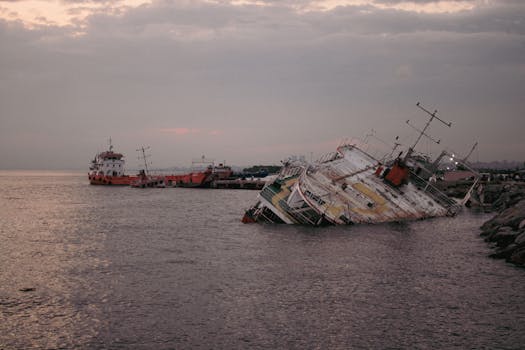
**
The sinking of the MSC Elsa 3 container ship off the coast of India in [Insert Date, if available, otherwise remove this phrase] highlighted critical vulnerabilities in the nation's maritime security infrastructure and exposed significant blind spots in its ability to effectively monitor and respond to maritime emergencies. This incident serves as a stark reminder of the urgent need for India to bolster its maritime domain awareness (MDA) capabilities, upgrade its technology, and enhance its coordination mechanisms. The event has sparked intense debate about India's maritime preparedness and the necessity for comprehensive reforms.
The MSC Elsa 3 Incident: A Wake-Up Call for India
The sinking of the MSC Elsa 3, [Insert details about the ship, cargo, and any casualties if available], underscored several key weaknesses in India’s maritime security framework. While the exact causes of the incident are still under investigation, the event raised crucial questions regarding:
Lack of Real-Time Monitoring: The delayed response to the incident raised concerns about the inadequacy of India’s real-time vessel tracking and monitoring systems. This lack of comprehensive surveillance capabilities leaves significant gaps in its ability to monitor vessels in its Exclusive Economic Zone (EEZ). This includes the lack of sufficient AIS (Automatic Identification System) coverage and the need for more advanced satellite-based monitoring systems.
Inadequate Communication & Coordination: Effective communication and coordinated response are crucial during maritime emergencies. The MSC Elsa 3 incident highlighted potential flaws in inter-agency communication and coordination between the Indian Coast Guard, the Navy, and other relevant authorities. Improved information sharing protocols and joint training exercises are urgently needed.
Limited Search and Rescue Capabilities: The response to the sinking, [Insert specifics about the response time and challenges faced, if available], highlighted limitations in India's search and rescue (SAR) capabilities, particularly in challenging weather conditions. This necessitates investment in advanced SAR equipment, improved training for personnel, and potentially an increase in the number of dedicated SAR vessels.
India's Maritime Blind Spots: A Deeper Dive
The MSC Elsa 3 incident isn't an isolated event; it's symptomatic of a broader set of challenges facing India's maritime security:
Coastal Surveillance Gaps: India's vast coastline, spanning thousands of kilometers, presents a significant challenge for effective coastal surveillance. The deployment of advanced technologies, including coastal radar systems, unmanned aerial vehicles (UAVs), and improved sensor networks, is critical to filling these gaps and improving MDA.
Cybersecurity Vulnerabilities: Maritime cybersecurity is another area demanding urgent attention. The increasing reliance on digital technologies in maritime operations makes India vulnerable to cyberattacks, which could compromise the safety and security of vessels and ports. Investing in robust cybersecurity infrastructure and training is essential to mitigate these risks.
Human Resource Limitations: The effective management and operation of India's maritime security apparatus requires a well-trained and adequately equipped workforce. This necessitates increased investment in training programs and the recruitment of skilled personnel across all relevant agencies. Furthermore, improved collaboration with international maritime organizations is crucial for information sharing and best practice adoption.
The Need for Technological Modernization:
Upgrading India's maritime surveillance technology is paramount. This includes:
Integrated Coastal Surveillance System (ICSS): Strengthening and expanding the ICSS is vital to provide real-time monitoring of maritime traffic and identify potential threats. This necessitates integration of various surveillance systems, including radar, AIS, and satellite-based systems.
Enhanced Vessel Tracking and Monitoring: Investing in advanced satellite-based tracking systems is crucial to improve the ability to monitor vessels within India's EEZ and beyond. This should include systems capable of tracking vessels even when their AIS transponders are switched off.
Strengthening India's Maritime Security: A Path Forward
The MSC Elsa 3 disaster should serve as a catalyst for much-needed reforms in India's maritime sector. Addressing the identified vulnerabilities requires a multi-pronged approach, focusing on:
Increased Budgetary Allocation: Sufficient funding is essential to support the acquisition of advanced technologies, the training of personnel, and the improvement of infrastructure.
Improved Inter-Agency Coordination: Strengthening communication and coordination protocols between different agencies involved in maritime security is vital for an effective response to emergencies. This requires regular joint exercises and the establishment of clear lines of communication.
International Collaboration: India must strengthen its collaborations with other nations and international organizations to enhance its maritime domain awareness and improve its response capabilities. Sharing intelligence and best practices is crucial in addressing transnational maritime threats.
Conclusion: Learning From the MSC Elsa 3 Tragedy
The sinking of the MSC Elsa 3 represents a sobering reminder of the challenges facing India's maritime security. While the exact causes remain under investigation, the incident exposed significant gaps in its monitoring, communication, and response capabilities. Addressing these vulnerabilities demands immediate action through technological modernization, enhanced inter-agency cooperation, and increased budgetary allocation. Failure to act decisively will leave India vulnerable to future incidents and compromise the safety and security of its maritime domain. The nation must learn from this tragedy and implement comprehensive reforms to ensure its maritime security is robust, resilient, and capable of meeting the challenges of the 21st century.




















